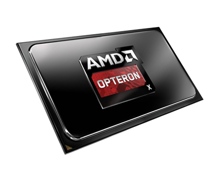
In occasione dell'evento Red Hat Summit 2014, tenutosi di recente in quel di San Francisco in California (U.S.), Advanced Micro Devices ha esibito pubblicamente un server basato su una APU di nuova generazione Opteron X (nome in codice: Berlin) in ambiente Fedora Linux, che sappiamo essere sviluppato dal Fedora Project, sponsorizzato a sua volta da Red Hat.
La demo di AMD è particolarmente interessante dal punto di vista tecnologico poichè presenta al grande pubblico i prodotti Opteron X, ovvero i primi chip dedicati all'ambito server in grado di vantare il supporto della tecnologia
Accelerated Processing Unit (APU), che il maker statunitense ha finora commercializzato esclusivamente per i sistemi di tipo desktop, notebook e, più di recente, embedded.
Le APU Opteron X sono basate su una componente CPU che integra quattro core x86 a elevata efficienza energetica, realizzati in accordo all'architettura Jaguar, e una componente GPU di classe Radeon HD 8000, che implementa l'architettura
Graphics Core Next (GCN), ampiamente pubblicizzata dal marketing AMD negli ambiti relativi a sistemi desktop e notebook.
Completano la dotazione dei chip Opteron X un memory controller per DDR3 con ECC e le funzionalità tipicamente offerte dai chipset legacy chiamati northbridge e southbridge, tra le quali non soltanto la gestione delle periferiche di I/O,
mediante il supporto nativo degli standard PCI-Express Gen 2, SATA II e SATA III, USB 2.0 e USB 3.0, ma anche Unified Video Decoder (4.2) e Video Compression Engine (2.0).
Ma l'obiettivo primario della demo, dichiarato dalla stessa AMD attraverso il comunicato stampa che vi proponiamo di seguito in versione integrale, è rappresentato dalla necessità di superare la riluttanza, finora manifestata dalle
aziende, nei confronti dell'adozione dei server basati su APU x86, e più in generale sull'architettura Heterogeneous System Architecture (HSA), per i propri data center.
E in questa ottica possono essere inquadrate le considerazioni sulla HSA, che non è soltanto un nuovo modo di produrre e fabbricare l'hardware, ma anche una nuova generazione di soluzioni a livello software, come dimostra il "Project
Sumatra", che pone al centro del mondo le APU per server e le applicazioni scritte in linguaggio Java, capaci di accedere in maniera altamente efficiente alle funzionalità grafiche, e dunque alla GPU, delle APU. HSA promette, inoltre,
anche il pieno supporto di altre tecnologie di primo piano nell'ambito grafico e multimediale server-oriented, come OpenCL e OpenGL.

[Immagine ad alta risoluzione]

AMD (NYSE: AMD) today announced another major milestone in the development of its enterprise software ecosystem with the first public demonstration of its second-generation AMD Opteron X-Series APU, codenamed "Berlin," running a Linux
environment based on the Fedora Project. The Fedora Project is a Red Hat-sponsored, community-driven Linux distribution, providing a familiar, enterprise class operating environment to developers and IT administrators worldwide. This is
important to companies looking to transition to x86 APU servers but who are reluctant to introduce new tools and software platforms to their IT environments. This demonstration also represents a significant step forward in expanding the
footprint of x86 APU accelerated performance within the data center.
AMD's premiere demonstration of "Berlin" will showcase the world's first Heterogeneous System Architecture (HSA) featured server APU ahead of its official launch later this year. The demonstration features advancements incorporated in
"Project Sumatra" that enable Java applications to take advantage of graphics processing units (GPUs) within AMD server APUs. The combination of Linux and Java on AMD APU platforms provides an ideal platform for server-based multimedia
workloads and general purpose GPU compute that will help drive new levels of workload efficiency in the data center. AMD also will demonstrate software-based on OpenCL and OpenGL on "Berlin."
"As servers adapt to new and evolving workloads, it's critical that the software ecosystem support the requirements of these new workloads," said Suresh Gopalakrishnan, corporate vice president and general manager of the Server Business
Unit, AMD.
"We are actively engaged with a broad set of partners in the data center software community who are bringing to market the software infrastructure to seamlessly enable x86 APU based servers."
AMD is a founding member of the HSA Foundation, an organization dedicated to building robust ecosystems to support APU technologies. For more information please visit AMD's booth 621 at the Red Hat Summit today and tomorrow where the HP
Moonshot M700 Cartridge based on the AMD Opteron X-Series X2150 APU, the upcoming second generation AMD Opteron X-Series "Berlin" APU, and the AMD SM15000 servers as well as partner technologies will be on display.
News Source: AMD Press Release
Links
|